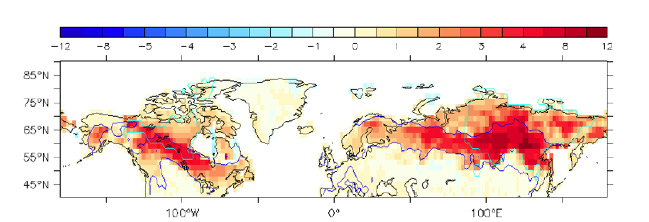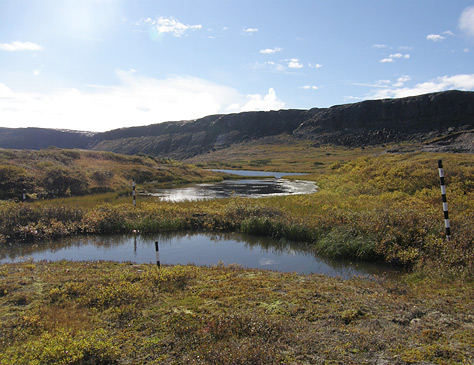Objectives
Thermal regime of permafrost
The complexity of snow-vegetation interactions has challenged process modeling and has prevented their detailed inclusion in LSMs. For example, when shrubs grow on grass tundra, effects include a decrease in albedo [18], the trapping of blowing snow and the shielding of snow from wind erosion [19]. Furthermore, shrubs limit snow compaction and density, favoring the formation of depth hoar layers of low conductivity that prevent ground cooling [6]. Current modeling studies [20] and observations [21] indicate that shrubs lead to increased soil temperature year-round, suggesting a likely positive feedback between climate and vegetation in the Arctic. However, to date, very few of these process studies have been incorporated into the LSMs coupled to climate models, so that predicting permafrost fate is highly uncertain. In fact, a recent climate model intercomparison [17] showed a huge range of predictions in permafrost extent. This forces us to conclude that the current treatment of permafrost thermal regime in climate models is not satisfactory.
Using ORCHIDEE, we modeled the soil thermal regime in the continental pan-Arctic area (>50°N) under 2 scenarios: (1) CTRL where the impact of vegetation on snow physical properties is neglected; uniform snow thermal conductivity and density of 0.2 W m-1 K-1 and 330 kg m-3 were prescribed. (2) VARIED where values of 0.25 and 0.07 W m-1 K-1, and of 330 and 200 kg m-3 were used for tundra and taiga, respectively. Figure 2 shows that these vegetation effects change soil temperatures at 50 cm depth by up to 10°C, which obviously can have a huge impact on carbon release and mineralization. This spectacular result attracted the attention of the scientific press and was highlighted in Nature Climate Change [22] and in Science News [23]. It is caused by the effect of just one of the processes mentioned so far, and including other effects such as albedo changes is critical, but data are presently lacking. Given these findings, we improved the treatment of snow thermal conductivity in ORCHIDEE, and this led to significant changes in predicted soil temperature and in the soil carbon budget [24].
Figure 1
Average vertical profiles of snow thermal conductivity, keff, at Barrow (Alaska, 71°N, tundra environment) and Sodankylä (Lapland, 68°N, typical taiga). The error bars are the standard variations of the measurements. They are larger at Barrow because the high wind speeds there lead to spatially heterogeneous snowpacks. After Gouttevin et al. [6].

Second, Brun et al. [25] improved the treatment of some snow-wind interactions in the detailed snow model Crocus coupled to the LSM ISBA to simulate the transformation of the Siberian snowpack layers over open-fields into depth hoar, leading to very low densities and high thermal resistance. Taking these processes into account enabled the simulation of the soil near-surface temperature over Siberian open fields in a quite realistic manner. Of course, further improvements are required and variables such as the vertical snow density profiles are not entirely satisfactory, but the data expected within this project should allow significant improvements in snow models and therefore in simulations of the permafrost thermal regime.
Building on these studies, the first overarching objective of this project is: “Make major improvements in our prediction of the thermal regime of permafrost by taking into accounts feedbacks between snow, vegetation, permafrost and climate.” This will be achieved by collecting novel and innovative data on snow and soil physical properties using instrument deployment and field campaigns, benefiting from the network of field stations of the Centre d’Etudes Nordiques of Université Laval (CEN-UL) in the Canadian Arctic and subarctic.

Figure 2
50 cm soil temperature difference (°C, top color scale) between the VARIED and CTRL simulations for the period 1970-2000, over the January-March period, illustrating the impact of snow thermal conductivity on soil temperature. Using actual thermal conductivity values predicts soil temperatures up to 10°C warmer.
Fate of organic matter in permafrost
The fate of OM in thawed permafrost is likewise poorly understood, and we illustrate only some of the current problems below. How the different components of C fluxes between boreal soils and the atmosphere will change with climate is complex and difficult to predict [26]. In aquatic systems, many processes such as OM photolysis are only started to be quantified for specific systems. Recent data from our team [3] show that photolysis of OM in thermokarst ponds can considerably accelerate the decomposition of dissolved organic matter relative to microbial processes alone, so that photolysis simply cannot be neglected in models. OM can be exported before being decomposed in ponds [10]. Decomposition and emission as GHG can proceed in rivers and the sea, and the fraction that will eventually be sedimented in rivers or oceans appears to be poorly understood, and greatly varies between systems [11, 27-29].
Current models have difficulties capturing these processes and often simply ignore them. For example, almost all CMIP5 simulations designed to inform the 5th IPCC Report showed that the continental high northern latitudes would turn into a carbon sink under the RCP8.5 CO2 emission scenario. This is in striking contradiction to the current understanding of the dynamics of the high-latitude carbon stocks, but this is not surprising because for example no CMIP5 model includes frozen carbon feedbacks [30]. Since moreover the specific properties of this soil carbon reservoir are ignored, the simulated carbon storage in the high-latitude vegetation increased because of climate warming and CO2 fertilisation.Our current understanding suggests that, while high-latitudes might indeed represent a transient carbon sink due to the growing above-ground carbon reservoir, the sign of the net flux is likely to reverse within a matter of decades because of the large size of the permafrost carbon reservoir. However, model confidence is very low in the prediction of these fluxes [30], stressing the urgent need for process studies and feedback quantification.
While the fate of OM from thawing permafrost is such a complex issue that it cannot be solved in any one project, we will attempt to make significant contributions, and the second overarching objective of this project is:
“Improve our understanding of the fate of permafrost OM in wetlands and thaw ponds, quantify their GHG emissions to the atmosphere and their export of OM to the hydrosphere.”


